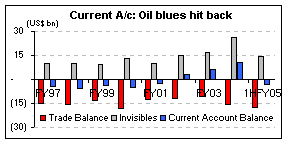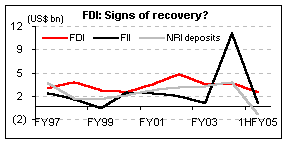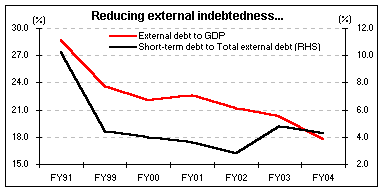|
|
| Help | |
| You are here: Rediff Home » India » Business » Special » Features |
|
The outlook for the external sector in 2003-04, as portrayed by last year's economic survey, read - 'After a subdued performance activity for nearly three years, global economic activity is finally showing distinct signs of revival. The optimism about a buoyant economic global economy emanates largely from a turnaround in the US and the robust growth outlook for emerging Asia.'
The actual performance for the aforesaid period has been bang on target. The US has indeed shown some signs of recovery and Asia continued to be buoyant, giving pep up to the global numbers, as compared to 2003. Let's analyse this performance in detail, both globally, and then with an India-centric view.
For the uninitiated, 'external sector' refers to the country's performance on the foreign front (exports, imports, foreign debt and investments and exchange rate).
Global performance in 2004
The developed circle: The US saw sustained recovery in most of 2004 and is estimated to clock a GDP growth of 4.3% in 2004 as per the IMF.
However, the world body did admit that the world's largest economy witnessed some slowdown in the latter part of the year and has therefore, marked its GDP growth estimation for 2005 downwards to 3.5%.
Indications of broad growth were visible in the Europe Union as well, led by the UK, Germany and France. The growth forecast is stable for this region in 2005 as well. However, this is contingent to how well the European Union (EU) is able to integrate the 10 new economies joining the EU.
Among the other advanced region, Japan too is expected to bounce back well in 2004, but a slowdown in 2005 is on the cards.
| GDP growth (%) | 2001 | 2002 | 2003 | 2004E | 2005E |
| US | 0.5 | 1.9 | 3.0 | 4.3 | 3.5 |
| EU | 1.6 | 0.8 | 0.5 | 2.2 | 2.2 |
| CIS countries | N.A. | 5.4 | 7.8 | 8.0 | 6.6 |
| Developing Asia | 5.6 | 6.6 | 7.7 | 7.6 | 6.9 |
| China | 7.5 | 8.3 | 9.1 | 9.0 | 7.5 |
| India | 4.0 | 5.0 | 7.2 | 6.4 | 6.7 |
| World Trade Volume (% growth) | 0.1 | 3.3 | 5.1 | 8.8 | 7.2 |
Emerging markets -- The buoyancy is for real: The emerging markets continued to outpace their developed peers led by Asean, India, China and the CIS countries (see table). While China is expected to marginally slowdown in 2005, India is likely to sustain its 6.5% GDP growth.
Based on the above factors, the world economic outlook suggests that the globe will clock a 5% growth in 2004 and about 4.3% in 2005.
India story -- 2004 and beyond
India's current account surplus, which ended on a positive note in FY04 ($10.6 bn), has shown indications of a negative bias in the first half of 2005 (1HFY05), owing largely to the escalating oil bills (current account deficit of $3.3 bn) and buoyant imports (up 39% YoY). FY04 saw almost doubling of the capital account surplus ($20.9 bn) led by tripling of the foreign investment flows in the country.
FII investments were the key driver for this trend. As a matter of fact, FII inflows into India, which were at a low of $0.4 bn during FY03, reached an all time high of $11 bn during FY04. In the first half of FY05 too, the country has recorded a healthy capital account surplus of $10.1 bn, but this figure is slightly lower than corresponding period of last year.
Statistics suggest that FIIs during this period (1HFY05) have failed to maintain the momentum witnessed in FY04. With a scenario of rising interest rates looming large in the US, one cannot rule of a relative disenchantment of the FIIs going forward.
 |  |
FDI -- Encouraging signals: But in this whole performance, one key indicator needs to be highlighted. The FDI flows, which continued to stagnate at $3.4 bn even in FY04, may be in for a recovery in FY05. In 1HFY05, FDI inflows crossed $2 bn.
While this is not much of an increase, but in light of the government moves to relax norms in telecom, insurance, construction, airports and also the scrapping of press Note 18, India can look forward higher FDI flows into the country in the years to come.
A strong balance of payments position in recent years has then led to a strong and steady rise in the level of foreign exchange inflows into the country, one of the major reasons for the continued appreciation of the Indian rupee.
As a matter of fact, vis-�-vis the US dollar, the Indian rupee has appreciated by more than 5% at the end of 2004, as compared to 2003 year-end. Being the sixth-largest reserve holder in the world, India' forex reserves currently stand at over $128.9 bn (February 4, 2005). A major reason for the rise in forex reserves has been strong capital inflows into the Indian markets.
Apart from appreciation in the value of the rupee, these inflows have resulted into increased money supply into the Indian economy, which despite the Central government's high borrowings, has led to interest rates remaining remarkably under control.
Debt count: However, while low domestic interest rates have aided the increase in government's internal debt, the economic survey has stated that a prudent external debt management policy pursued over the last decade has improved the country's external debt position to a comfortable level. India's external debt stock, which was $84 bn during 1990-01, stood at $112 bn at the end of FY04 ($114 bn in September 2004). This debt works out to be 17.8% of India's GDP.

As a matter of fact, after being among the top 3 debtor countries in the world in 1991, India has improved its position to 8th. Though one would like the country to not figure in the top 15 debtors of the world, the situation however, looks much more under control.
All the more important, India's short-term debt to total external debt ratio in 2004, at 4.3%, is much lower than that for China (28.5%), Russian Federation (11.1%), Brazil (10.3%) and Thailand (20.1%). However, this figure has risen to 5.7% in 1HFY05 with rise in import related credits.
Outlook
As regards to the GDP growth outlook, we believe that India, China and the Russian region will continue to be key contributors to global growth. With regard to India, steps to increase FDI are likely to help the country witness record FDI inflows over the next 2 to 3 years.
However, the world's largest economy's deficit (the US) continues worry us. This is likely to result in either a sharper hike in interest rates in that region, or a devaluation of the Chinese currency. In both scenario's, the after effects will be felt across the globe.
For India, the encouraging aspect is that it is not overtly dependent on the western economies for growth (exports contribute to around 12% of GDP while international trade accounts for 25% of GDP).
The country, by and large, is still internal demand led. We believe that continuing reforms will aid this momentum over the next 3 to 5 years, barring a few hiccups in between.
This is part of Equitymaster's Budget 2005-06 series. Equitymaster.com is one of India's premier finance portals. The Web site offers a user-friendly portfolio tracker, a weekly buy/sell recommendation service and research reports on India's top companies.
More Specials
|
|
| © 2008 Rediff.com India Limited. All Rights Reserved. Disclaimer | Feedback |
